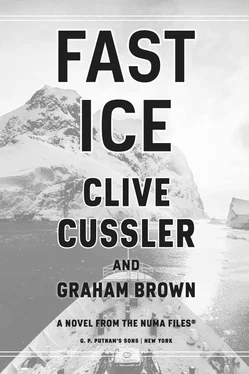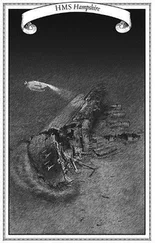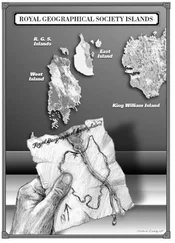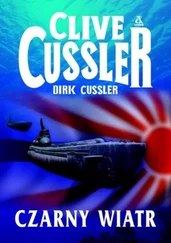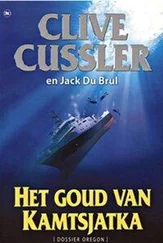Higher up, the ground was hard and icy. The fresh snow from this part of the ridge had been swept away. Joe had to be farther down.
Kurt moved lower until he came to an area where his boots sank halfway to his calf. Here he widened his search and picked up the pace. He soon found a glove, and then a hat, but neither item was NUMA issue. A minute later he came upon a section of tread that had been torn off the snowcat. Broken bits of plastic lay nearby, but still there was no sign of Joe.
He swung back the other way, trudging through the snow and burying his chin in the collar of his jacket to keep it out of the wind.
He looked and looked and then stopped. How many yards had he gone? He turned around to find he’d wandered farther this time. The cold and the exhaustion had started to affect him.
He dropped down a few more yards and started back toward his centerline. His watch read 3:21. “Come on, Joe,” he muttered through numb lips. “Give me a sign.”
Catching his foot on something, Kurt fell to his knees. Turning with a start, he reached for the offending object and brushed the snow away. A handlebar appeared, and then the stub of a shattered mirror. It was the NUMA snowmobile.
Common sense told him Joe should have ended up near the machine, but common sense didn’t always hold in the chaos of an avalanche. Kurt stood up, looking around in all directions. He had to start digging soon, but where?
An idea came to mind, and Kurt began digging right where he stood. He jammed his hands into the snow and scooped out large heaps of the frozen and crystallized water. He worked with absolute intensity, his heart pounding against the wall of his chest, his head throbbing.
With the snowmobile over on its side, Kurt was able to clear the area around the seat and soon found what he was looking for: the tablet computer that Joe had used to navigate.
The screen was cracked and the stand it was locked into had been bent to one side, but the device lit up when Kurt touched it.
Unlocking the clamp that held it, Kurt pulled it free and opened a program. Thankfully, NUMA gloves were designed to work with iPads and other touch screens.
After launching the tracking program, Kurt tapped the search icon. The expedition jackets contained tracking beacons. If Joe was lying in the snow somewhere, the warmth from his body and the heated clothing would melt enough ice to make the sensor think he’d fallen overboard. Or if Joe’s hand was in the right place, he could activate the beacon himself.
After Kurt waited for what seemed like an eternity, the GPS localized and a signal appeared.
Kurt estimated the bearing and charged downhill. As he closed in on the spot, the snow grew deeper and softer. Soon he was sinking halfway to his knees.
He stopped directly on top of the marker. There was no sign of Joe at the surface, but considering the GPS was accurate to within eighteen inches, Joe had to be right beneath him.
Kurt put the tablet down and started digging, excavating the first foot of snow in a few quick scoops. The second foot was removed just as easily but the deeper Kurt went, the harder it was to dig.
He widened the hole, dropped down into it, and kept digging until his hand hit something metal. Scraping the snow away, he discovered a long narrow shaft. One end had a spear-like tip while the other was wide and flat.
Kurt pulled it free and began using it as a shovel, digging with the flat end and heaving the snow over his shoulder as he went. His pace quickened. He’d soon created a pit almost as wide as it was deep. He stopped when he noticed something in the dark.
Turning his own lights off, he waited a second for his eyes to adjust. A soft glow was rising through the crystalline snow. He could see the outline of a man.
Using the pointed end of the shaft, Kurt drilled carefully downward toward the figure. Pulling the shaft out, he drilled a second hole and then a third, all of them within inches of what he hoped was Joe’s face. The idea was to vent the carbon dioxide and allow oxygen to replace it. If he was close, it would give Joe more time.
After punching a half dozen holes as deeply as he dared, Kurt got back to digging. With two more feet of snow removed, he found Joe’s arm and then his shoulder.
Tossing the improvised shovel aside, Kurt dropped to his knees and began digging with his hands once again.
A swatch of dark hair appeared. Kurt grasped it and pulled.
“Joe,” he shouted. “Can you hear me? Tell me you’re alive.”
Joe’s eyes opened just a sliver and he coughed as if he were choking on something.
Kurt began brushing the snow from Joe’s eyes, clearing it roughly from his nose and mouth. “Are you all right?”
Joe blinked and squinted. “I will be,” he said. “When you stop scraping my face with your gloves like that.”
Kurt pulled his hand back and laughed. He went back to digging, clearing Joe’s arms and then his torso. Joe was soon squirming back and forth, trying to free his legs.
Kurt offered a hand, and with a powerful heave, he pulled Joe free.
Climbing out of the pit, both men collapsed against the pile of snow Kurt had excavated.
While Kurt allowed his muscles a well-deserved rest, Joe breathed deep and slow, replenishing the oxygen in his blood. He stretched every muscle, testing his limbs one by one. Incredibly, nothing was broken. “Next time,” he said, eyeing Kurt, “you push the button.”
Kurt nodded and laughed but said nothing. He noticed Joe looking past him, out across the slope to where the exposed tail of the old German flying boat was lit up by the flare.
“When did that get here?” Joe asked, sounding puzzled.
“About eighty years ago,” Kurt said. “It’s Jurgenson’s plane.”
“You’re kidding me?”
“Nope.”
“I suppose that explains your shovel,” Joe said, pointing to the makeshift tool that Kurt had used to dig him free.
Kurt turned toward it, examining it in detail for the first time. It was a three-foot shaft of metal with a weighted point at one end and broad fins at the other. Only now did Kurt see the slightly raised image of swastikas on each of its tail fins.
Kurt shook his head at the discovery, wryly amused. “Well,” he said. “At least we know we’ve come to the right place.”
51
With no one on their tails, Paul and Gamay cruised safely across the surface of the glacier. They rode on a foot of soft powder that cushioned the ride and muffled all sound.
With the lights off, Paul was driving almost blind, but Gamay kept up a steady stream of directions, vectoring him around obstacles and toward the target.
“Wish I could see more than fifty feet ahead,” Paul announced.
“Just keep your eyes on the road and do everything I tell you,” Gamay said.
“You must be loving this,” Paul joked. “It’s every backseat driver’s fantasy.”
She laughed. “Bear to the left fifteen degrees. And pick up the speed, you’re driving like my ninety-year-old nana.”
Paul smiled and did as directed. They swung out wide and then back to the pumping station. Once he turned toward it, there was no mistaking the target. In a sea of gray and black, the station appeared on the infrared screen like an inferno. Heat poured from several individual vents, trailing away on the wind, while a few dim lights illuminated the area around it.
As they closed in on the target, Paul slowed their approach. What appeared to be blazing fires on the infrared screen were actually plumes of superheated steam blasting out of several pipes.
The steam rose into the air, streaming on the breeze and condensing into snow. It fell in huge piles, creating a small hill downwind of the station.
Paul came in behind one of them, using it to shield them from any lookouts or cameras. With the motor disengaged, the snowmobile stopped directly behind the artificial ski slope.
Читать дальше
